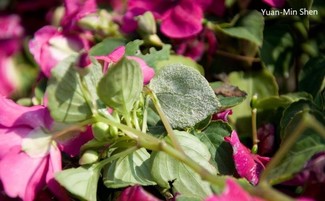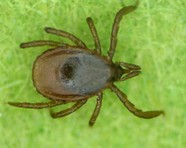Horticulture
In this issue:

In 2013 most Maine growers cut back or suspended impatiens production due to widespread infections of impatiens downy mildew (IDM), Plasmopara obducens, in the United States. Recently, the University of Maine Cooperative Extension positively identified IDM on an impatiens sample submitted from here in Maine. This is a very early find, and the cool moist weather conditions we have had lately are ideal for development of this disease. While there have not been outbreaks in our area for many years, this is a good reminder to be vigilant in scouting and managing cultural conditions to prevent disease; once the plant is infected there is no treatment or cure.
Symptoms to scout for:
- Pale or chlorotic foliage that looks similar to a nutrient deficiency
- Distorted, wilting, or downward curling of leaves
- Inconspicuous mottling and stippling
- White or light gray/purple fuzz on the undersides of leaves
- Stunting of plant growth/malformation of leaves and flower buds
- Leaf and flower bud drop resulting in leafless stems
- Advanced infections result in severe defoliation and plant death
What you can do to prevent IDM:
- Plant resistant varieties such as Imara XDR (Syngenta Flowers) and Beacon (PanAmerican Seed)
- Scout incoming plant material and keep plants from different sources separated
- Continue to scout for symptoms weekly
- Water plants at a time of day that allows the foliage to dry quickly
- Keep the relative humidity in the greenhouse low, and temperatures above 73°F
- Protect impatiens crops with preventative fungicides
More information on IDM and the current recommended preventative fungicide application schedule from Michigan State University
If you see symptoms of IDM on your impatiens, please contact the Horticulture Program at horticulture@maine.gov.
|

Ticks don’t do physical distancing. In fact, they can be down-right clingy. While focused on keeping six feet between people to reduce the spread of coronavirus don’t forget about the importance of keeping yourself, staff, and customers away from disease-carrying ticks. May is Lyme Disease Awareness Month and the perfect opportunity to offer customers and staff information and resources for avoiding ticks and staying healthy.
Create Tick Resistant Landscapes
-
Reduce tick habitat and shade: Ticks, especially the disease carrying black-legged tick (also called deer tick), thrive in shady, humid conditions primarily in and near woods and fields. Chances are you are already familiar with the most tick-prone areas of your properties. For tick-prone areas frequented by people, maintain and prune shrubs, trees and garden beds to reduce shade. Keep these areas free of weeds, brush and leaf litter. Bush-hog and weed-whack where needed to keep grass and weeds cut low. Avoid low-growing ground cover plantings such as pachysandra. Focus your anti-tick landscaping in areas frequented by customers and staff.
-
Discourage rodents: Small rodents are part of the tick-borne disease cycle. Ticks acquire these diseases from mice and other small rodents. To discourage rodent activity, keep foundations in good repair. Seal off potential rodent-entryways in and under buildings and sheds with 1/4" hardware cloth or sheet metal. Mow, bush-hog, weed-whack and prune to eliminate grassy, brushy and shrubby areas that harbor rodents. Do not allow stacks of materials (such as unused equipment, lumber, brush piles) to sit on the ground. Remove or raise them well off the ground to eliminate potential rodent harbitat. Discontinue feeding birds in spring and summer. Clean up dropped seed under feeders.
-
Direct people away from ticks: Use signage and barriers to keep customers away from tick infested areas. Direct foot-traffic to stay on open, dry ground as much as possible. Clear and widen trails.
Train Staff
-
Emphasize personal protection: Train staff to use proper personal protection measures including wearing light-colored long sleeves and long pants tucked into socks or boots, the use of EPA-registered repellents on exposed skin and doing a full body check for ticks at the end of the day. Repellents containing picaridin or at least 20% DEET are most effective. Permethrin-treated clothing and gaiters are very effective in reducing the risk of tick bites. Post signs to remind staff to stay vigilant. See US CDC or Maine CDC for more guidance on personal protection
Resources
|
May is traditionally the busiest month for greenhouses with crowds of customers flocking to buy plants. There seems to be an increased interest in gardening this year, which will hopefully translate into increased plant sales. The question remains, will the demands of social distancing allow you to sell your crops when you planned or will you need to hold finished plants longer than expected? Here are some tips for keeping your plants at their best and ready for sale:
-
Manage fertilizer and water. Provide adequate fertilizer, but don’t overdo it; too much fertilizer will encourage growth. Improper watering will stress plants making them more susceptible to pests.
-
Reduce greenhouse temperatures. Lower temperatures will help slow plant growth as will manipulating DIF (the difference between your daytime and nighttime temperatures).
-
Provide adequate space for plants. Spacing plants will prevent plants from stretching as they compete for light as well as increase air circulation which can help prevent disease.
-
Scout for pests and diseases. Find pest infestations early before they damage plants. As plants get bigger it may become more difficult to find and manage pests.
-
Consider using a plant growth regulator (PGR), pinching or cutting back plants. These methods should be used as a last resort as the plant will need time to recover from treatment before it will again be ready for sale.
Need More Information?
|